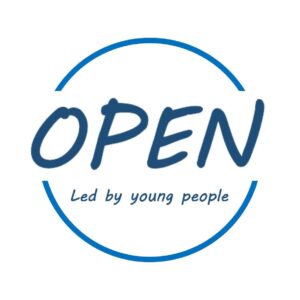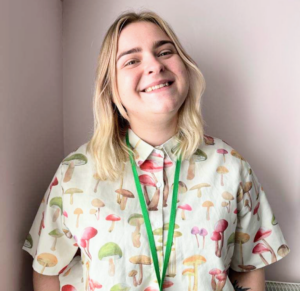Between 2021-2023 with funding from the Ideas Fund, young people from the OPEN Project in Shetland were matched with professional researchers to support them to conduct research firstly on a space for young people and then the impact of alcohol and other drugs.
In this blog series, one of the peer researchers for the project Shannon Boston is sharing their research journey, what they’ve learned, what tools they’ve used and what support they received along the way.

We started OPEN’s alcohol and other drugs research project in September of 2022, me and Akira were back in the office ready to hit the ground running. The reason for our new research project came from the findings from the OPEN space project, young people themselves had identified that with nothing to do and nowhere to go that their options were limited, other than mooching about the town or paying to go somewhere there was nowhere that was their own.
We wanted to find out if because of this alcohol and other drugs are being accessed by young people. The Shetland alcohol and drugs partnership ( SADP) agreed to work alongside us on the project as they had identified that there are no services available to support young people below the age of 16 if they are using substances and want to access support.

In our previous project professional researchers Amy Calder from YouthLink Scotland and Jennifer Russell from Anderson Solutions gave us a guiding hand and guided us through our work to complete the project. The professional researchers are teachers to us Peer Researchers and provide wisdom and insight on projects.
In the previous project we had worked with the Miro Board, it’s an interactive whiteboard platform that we could work on. Jennifer is the Miro board master, Akira and I met Jennifer online via zoom to create a new Miro board for this project Miro is so easy to use and it is really helpful to have all your thoughts in one place alongside being super helpful for seeing our timeline.
We discussed the project name and felt that instead of the alcohol and drugs project we would say the alcohol and other drugs project. This is because we didn’t want alcohol to seem separate to drugs, we felt that stating other drugs made the distinction that we do not feel alcohol is separate.
The Miro Board is where we start working on our core questions for the project, digging deep into what we want to find out and why we would want to find out the information. Honestly I struggled to get my head in the game when it came to understanding why we were doing the research without going down rabbit holes of questions I was curious about. Staying neutral and on task seems easy now but I remember wrestling with my own preconceptions at the start but really once I understood that we were exploring drug culture in Shetland, what it looked like and the impact on our culture through young people’s eyes.
Our core questions are:
Akira and I use the core questions in focus groups and interviews, we use different interactive methods to ask the questions above and would use the end of sessions to reflect quietly, finishing off with our “hard hitter” an envelope with this question inside it:
If you could wave a magic wand, what would be the single most effective thing that could be done to reduce harm and support young people affected by alcohol and other drugs in Shetland?
Using Miro really helps us to shape our focus groups and interviews. Jennifer is a research consultant who works alongside me and Akira guiding us in our work, we would be lost without her, she has really helped me with any mental block I’ve had when it has come to our core questions and she’s really good at seeing the bigger picture of projects. Things would move so much slower without Jennifer helping us the first couple months of each project figuring out the how’s and whys.

Once our core questions were plotted out we were ready to try out focus groups and interviews. Akira and I began interviews and started planning for Amy and Jennifer to take a trip up to Shetland to work with our volunteers and get us settled into the rhythm of running focus groups.
In November Amy and Jennifer arrived in Shetland for a fly in visit. We spent the day meeting with them, Wendy McConnachie from the SADP joined us to give her perspective and we discussed our core questions, what we hoped to learn and what we hoped the research would achieve, which is to understand alcohol and other culture through young people’s eyes and to identify whether there was a gap in substance support services for under 16s.
Amy and Jennifer ran a focus group with our volunteers in an evening session, we were aware alcohol and other drugs can be a sensitive topic so while Amy and Jennifer ran the focus group. Amy would pause on occasion to talk about the ethics and how to handle a situation or how to redirect someone when they are sharing something too personal while also still validating the participant’s opinion. Jennifer demonstrated the use of tone and use of space in the focus group, using a calm controlled voice and making use of the space whilst delivering the focus group to give the impression being relaxed and in control of the space.
At the end of the focus group we mentioned about recruiting for the research team for the alcohol and other drugs project and some volunteers put their name down to join the team.
Amy and Jennifer coming to visit had been so helpful, strengthening connections with our partners, taking us through the focus group plan and ethics surrounding the work we are planning to carry out during the project.
After hugs we said our “until next times”, me and Akira felt ready to start gathering data. More about our data gathering, project journey coming up, as well as our first official research team meeting!
Written by – Shannon Boston
You can listen to Shannon appear on BBC Radio’s Good Evening Shetland programme, where she discusses the findings of the research project in detail. Skip to 17.48 to catch Shannon’s apppearance!
This blog is part of a series, if you enjoyed reading part three, you can find the other parts of the series here.